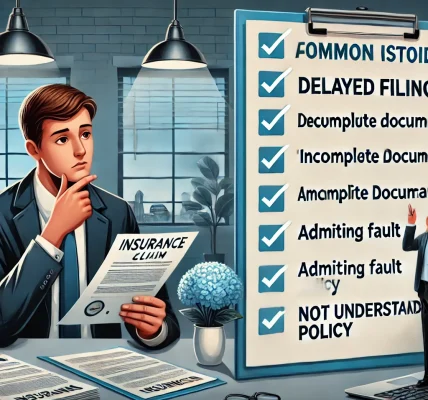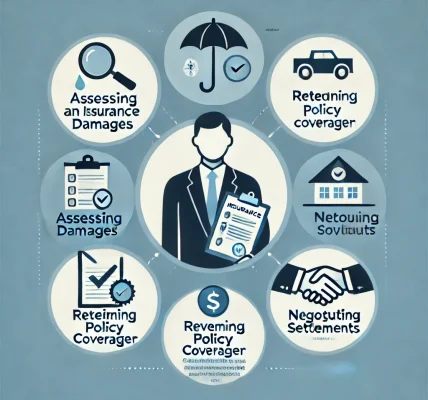When filing an insurance claim, one of the key professionals you will interact with is an insurance claim adjuster. Their role is crucial in determining the outcome of your claim and the amount you may receive in compensation. Understanding how claim adjusters work, their responsibilities, and how to communicate effectively with them can significantly impact your insurance claim process.
In this comprehensive guide, we will discuss the role of insurance claim adjusters, how they operate, and essential tips to ensure a smooth claims process.
Who is an Insurance Claim Adjuster?
An insurance claim adjuster is a professional hired by an insurance company to investigate and evaluate claims. Their primary job is to determine the extent of the insurer’s liability and assess the damages or losses claimed by a policyholder.
Types of Insurance Claim Adjusters
- Company Adjusters (Staff Adjusters) – Employed directly by an insurance company and handle claims on behalf of the insurer.
- Independent Adjusters – Work as third-party contractors and are hired by insurance companies to handle claims.
- Public Adjusters – Hired by policyholders to assist in negotiating claims with insurance companies.
The Role of an Insurance Claim Adjuster
An insurance claim adjuster plays a vital role in the claims process. Their duties include:
- Investigating the Claim: Assessing the validity of the claim by reviewing the incident, documentation, and policy coverage.
- Inspecting Damages: Examining property damage, medical records, or other relevant evidence.
- Interviewing Witnesses & Policyholders: Gathering statements from involved parties.
- Reviewing Policy Coverage: Ensuring that the claim falls within the terms of the policy.
- Negotiating Settlements: Determining a fair compensation amount based on damages and policy limits.
- Preventing Fraud: Identifying potential fraudulent claims to protect the insurer from false claims.
How Do Insurance Claim Adjusters Work?
1. Initial Contact & Claim Assessment
Once you file a claim, an adjuster will be assigned to your case. They will contact you to schedule an inspection or discuss details about the claim.
2. Investigation Process
The adjuster will gather evidence by:
- Visiting the scene of the incident (if applicable)
- Reviewing photographs and videos
- Examining receipts, medical bills, and other documentation
- Talking to witnesses or law enforcement
3. Damage Evaluation
After collecting all necessary information, the adjuster assesses the extent of damage and determines repair or replacement costs.
4. Policy Review & Coverage Determination
The adjuster compares the damages with the policy’s terms to decide how much the insurer will cover.
5. Settlement Offer
The adjuster will present an initial settlement amount based on their assessment. Policyholders can negotiate if they believe the amount is insufficient.
6. Claim Resolution
Once an agreement is reached, the claim is processed, and the settlement is issued to the policyholder.
How to Work Effectively with an Insurance Claim Adjuster
1. Be Prepared with Documentation
Provide clear and detailed evidence, including:
- Photos and videos of damage
- Receipts for repairs or medical expenses
- Police reports or witness statements
2. Understand Your Policy
Review your policy’s terms, coverage limits, and exclusions before discussing the claim.
3. Stay Professional and Courteous
Maintaining a polite and cooperative attitude can help ensure a smoother process.
4. Get a Second Opinion
If you feel the adjuster’s evaluation is unfair, consider hiring a public adjuster or an independent expert.
5. Negotiate if Necessary
If the settlement offer is too low, you have the right to negotiate or provide additional evidence.
Common Myths About Insurance Claim Adjusters
Myth 1: Adjusters Always Work Against Policyholders
Not necessarily. While they represent the insurance company, they are also expected to assess claims fairly.
Myth 2: You Must Accept the First Offer
Policyholders have the right to negotiate and provide additional documentation to support their claim.
Myth 3: Public Adjusters and Company Adjusters Work the Same Way
Public adjusters work for policyholders, while company adjusters work for insurance companies.
Conclusion
Understanding the role of an insurance claim adjuster and how they work can help you navigate the claims process more effectively. By preparing documentation, understanding your policy, and maintaining clear communication, you can ensure a fair evaluation of your claim.
If you ever feel unsure about the process, consulting a public adjuster or legal expert can provide additional guidance to help you achieve a favorable claim resolution.




